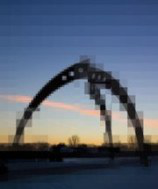Speaker
Summary
We present a new technique for the reconstruction, validation, and simulation of hybrid pixel hits. The technique is based upon the fitting of the cluster projections to pre-computed shapes or "templates". A detailed simulation called Pixelav that has successfully described the profiles of clusters measured in beam tests of radiation-damaged sensors is used to generate the cluster shapes. Although the technique was originally developed to optimally estimate the coordinates of hits after the detector became radiation damaged, it also has superior performance before irradiation. The technique requires a priori knowledge of the track angle which makes it suitable for the subsequent passes in a multi-pass reconstruction algorithm. However, the same angle sensitivity allows the algorithm to determine if the sizes and shapes of the cluster projections are consistent with the input angles. This information may be useful in suppressing spurious hits caused by secondary particles and in validating seeds used in track finding. In combination, the improved reconstruction and seeding significantly reduce the resolution tails of reconstructed track parameters and reduce the light quark background of tagged b-quarks by a factor of 2-3. Finally, a new procedure that uses the templates to re-weight clusters generated by the CMSSW simulation is described. This technique permits the fast simulation of pixel hits that have the characteristics of the much more CPU-intensive Pixelav hits and may be the only practical way to simulate radiation-damaged detectors in the full detector simulations of the LHC experiments.
